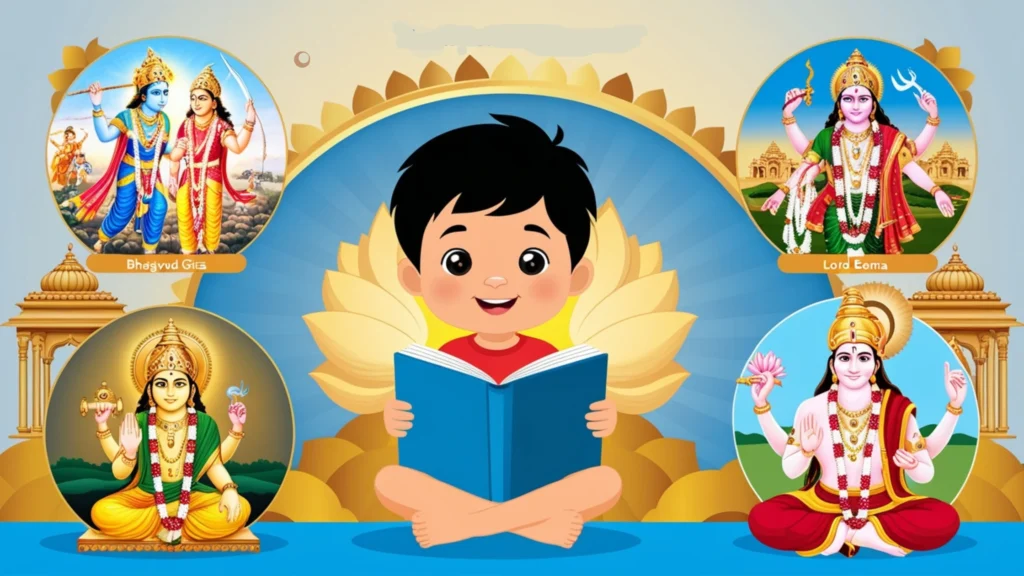Ethics and values are the foundation of a well-rounded individual, and introducing them early in life sets the stage for a responsible and empathetic adulthood. The Bhagavad Gita and the Ramayana, two of the most revered Indian scriptures, offer timeless teachings that can significantly influence the moral and ethical development of children. This blog explores the profound lessons these scriptures hold and how they can shape young minds.

Table of Contents
1. Why Ethics and Values Matter for Children
- Foundation of Character: Ethics and values help children differentiate between right and wrong.
- Social Harmony: They foster qualities like empathy, respect, and kindness.
- Resilience and Strength: They guide children to face challenges with integrity and courage.
Indian scriptures like the Bhagavad Gita and Ramayana provide relatable stories and lessons that make these values easier to understand and internalize for children.
2. Key Teachings from the Bhagavad Gita for Children
The Bhagavad Gita, a spiritual discourse between Lord Krishna and Arjuna, is a treasure trove of life lessons.
a. Duty and Responsibility (Karma Yoga)
- Teaching: “Do your duty without attachment to the results.”
- For Children:
- Focus on learning and doing their best, rather than worrying about grades or outcomes.
- Develop a sense of responsibility in everyday tasks.
b. Honesty and Truth (Satya)
- Teaching: Always align actions with truth and righteousness.
- For Children:
- Speak the truth and own up to mistakes.
- Build trust with parents, teachers, and peers.
c. Self-Control (Atma Samyama)
- Teaching: Mastery over desires, anger, and greed leads to inner peace.
- For Children:
- Manage emotions during conflicts or disappointments.
- Practice patience and understanding.
d. Resilience and Courage
- Teaching: Face challenges with determination and clarity of thought.
- For Children:
- Build confidence to tackle difficulties in academics or friendships.
- Learn to stay calm under pressure.
3. Key Teachings from the Ramayana for Children
The Ramayana narrates the story of Lord Rama, an embodiment of virtue and ideal behavior.
a. Obedience and Respect for Elders
- Teaching: Lord Rama obeyed his father’s command and willingly accepted exile.
- For Children:
- Listen to and respect parents and teachers.
- Value family traditions and teachings.
b. Integrity and Righteousness
- Teaching: Lord Rama always chose the path of dharma (righteousness).
- For Children:
- Stand up for what is right, even when it’s challenging.
- Make decisions that benefit others, not just themselves.
c. Sacrifice and Empathy
- Teaching: Sacrifice personal comforts for the greater good.
- For Children:
- Share with friends and siblings.
- Help others selflessly.
d. Loyalty and Friendship
- Teaching: The bond between Lord Rama and Hanuman is a symbol of unwavering loyalty.
- For Children:
- Be a supportive and reliable friend.
- Build trust and maintain relationships.
4. Practical Ways to Introduce These Teachings
a. Storytelling Sessions
- Narrate simplified versions of stories from the Gita and Ramayana.
- Use examples like Krishna guiding Arjuna or Rama fulfilling his duties to explain moral concepts.
b. Activities and Role-Play
- Organize plays or skits based on events like the battle of Kurukshetra or the exile of Lord Rama.
- Encourage children to act as characters and learn values through their roles.
c. Creative Engagement
- Use drawings, crafts, and puzzles themed around Indian scriptures to spark curiosity.
- Incorporate devotional songs or chants to make learning enjoyable.
d. Modern-Day Relevance
- Discuss how the teachings apply in everyday situations like sharing toys, resolving conflicts, or doing schoolwork sincerely.
Read more:-
बच्चों के जीवन में प्राचीन भारतीय ज्ञान का महत्व
How the Moon Got Its Light: A Bedtime Story
क्या बच्चों को देखनी चाहिए ‘भूल भुलैया 3’? जानिए इस फिल्म में बच्चों के लिए क्या है खास!
5. The Benefits of Teaching Ethics Through Scriptures
a. Emotional Stability
- Children learn to manage stress and emotions through self-control.
b. Enhanced Relationships
- Values like empathy, respect, and honesty improve interactions with peers and family.
c. Academic and Personal Growth
- The focus on discipline and duty helps children excel in academics and extracurriculars.
d. Spiritual Awareness
- Exposure to Indian scriptures fosters a deeper connection to their cultural roots.
1. What are the educational ethics and values of Bhagavad Gita?
The roles of students and teachers are defined, highlighting humility, receptivity, active participation, self-realization, compassion, guidance, and liberation. The Bhagavad Gita’s educational philosophy emphasizes self-awareness, duty, ethical conduct, holistic development, the pursuit of knowledge, and detachment.
2. How to teach children the Bhagavad Gita?
Chant Basic Shlokas :- Now, when the kid is aware of basic introduction of what is Bhagavad Gita, so it’s the time to make them the friends of Shlokas too, for that we can start with very basic and easy shlokas which are the shlokas from the first chapter, and not to overwhelm or overburden the kids
3. How do the teachings of Bhagwat Gita help students develop their personality?
Bhagavad-Gita’s Teachings teach the individuals to become self-controlled, selflessness, self-realization, self-study, self-regulation, self-discipline, self- development, and self-determination, self-confident, self-concept, self-esteemed, and so on.
4. What is values and ethics in education?
Ethics and value education are sought to be imparted to the students to create awareness and inculcate commitment among the students about social responsibilities and foster moral values in them, improving their quality of life through holistic education.
5. What is the concept of ethics in work life according to Bhagavad Gita?
One has the right to work, but never to the fruit of work
Here Krishna advises Arjuna to detach from being concerned with whether or not the duty bound action is successful or what rewards he will get, instead he should prepare himself to perform the action to the best of his ability.
The Bhagavad Gita and Ramayana are not just religious texts but profound guides to ethical living. By teaching these values to children, we empower them to lead meaningful, compassionate, and balanced lives.
Let’s introduce these timeless lessons to young minds and nurture a generation that upholds the virtues of honesty, duty, and selflessness.
“Empower your child with the wisdom of Bhagavad Gita and Ramayana – a step towards building a better future.”


